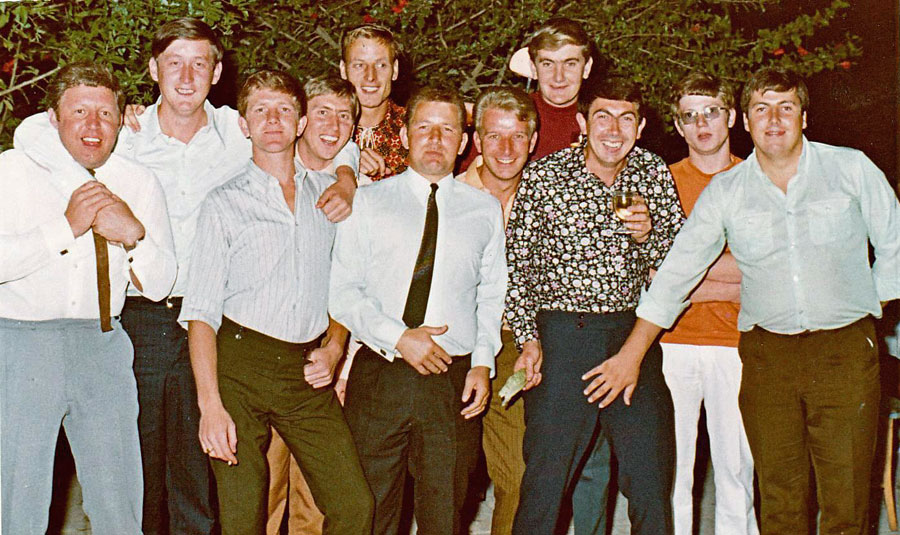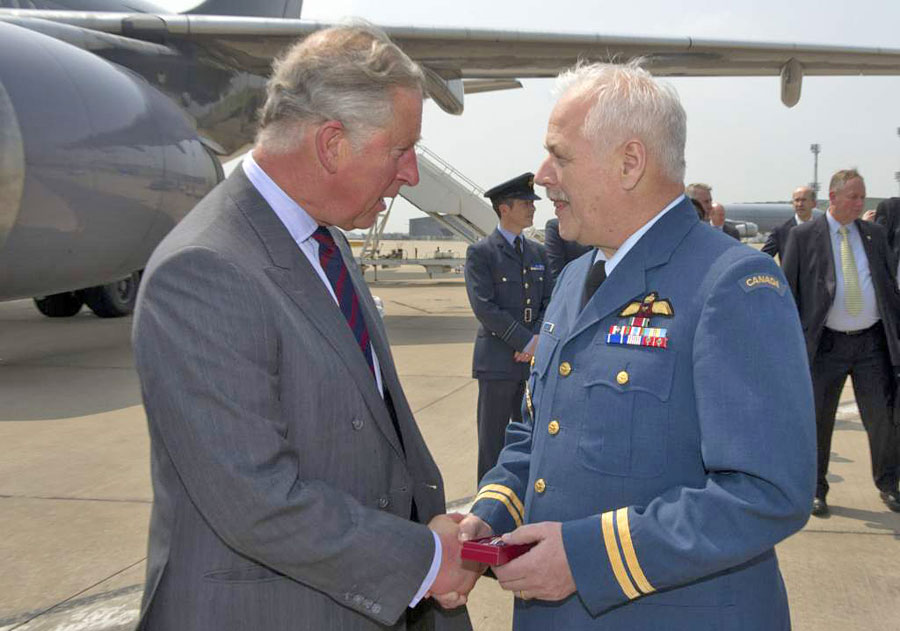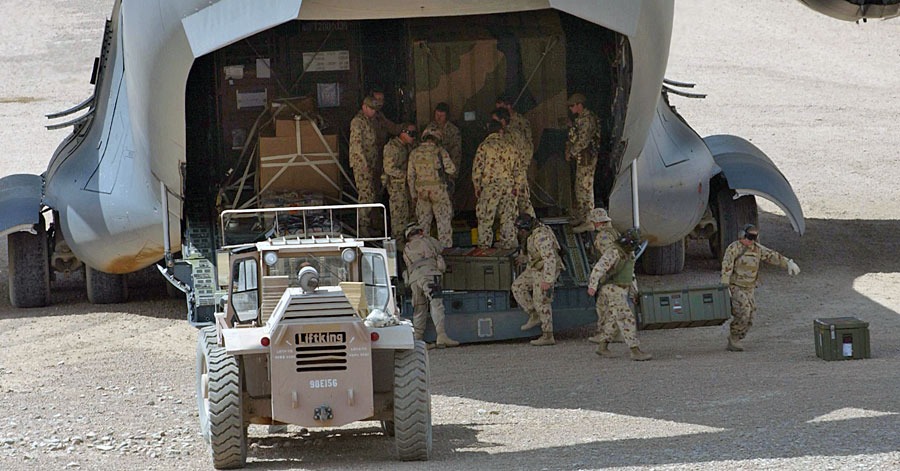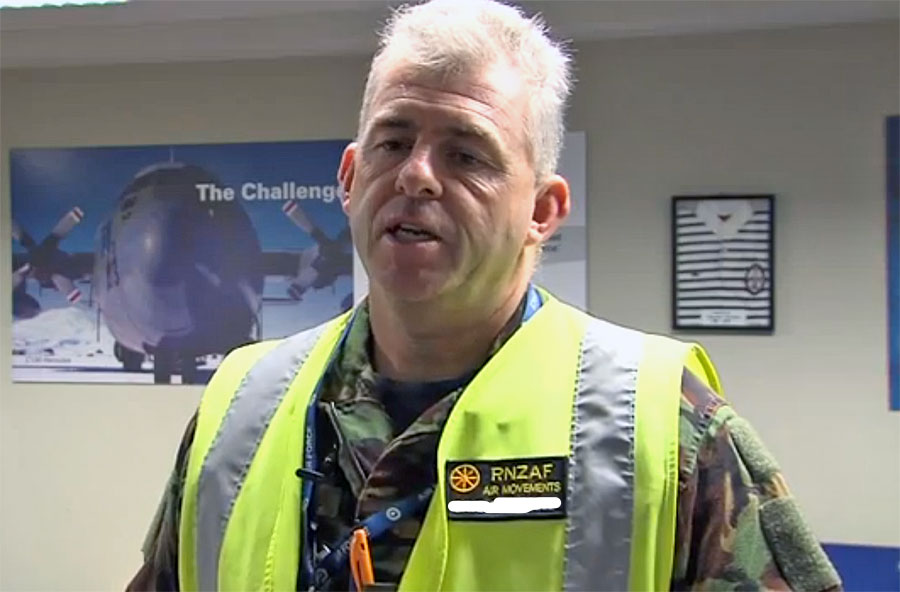From: Brian Kent, Carterton
Sent: Wednesday, September 04, 2013 8:49 AM
Subject: Trevor (Oz) Oswald
Hi Tony,
I would like to thank family, friends, St. Johns Church and the Golden Eagle Carterton for the memorable "sending off" occasion for Oz.
The church was full to capacity with an emotional service and atmosphere celebrating Oz's life. The applause outside the church as the coffin was placed into the hearse was very appropriate.
With many generations of Movers attending it was a walk down memory lane with the usual problem of putting together faces, names and places.
God bless you Oz.
Rest in peace.
Brian Kent
Sent: Wednesday, September 04, 2013 8:49 AM
Subject: Trevor (Oz) Oswald
Hi Tony,
I would like to thank family, friends, St. Johns Church and the Golden Eagle Carterton for the memorable "sending off" occasion for Oz.
The church was full to capacity with an emotional service and atmosphere celebrating Oz's life. The applause outside the church as the coffin was placed into the hearse was very appropriate.
With many generations of Movers attending it was a walk down memory lane with the usual problem of putting together faces, names and places.
God bless you Oz.
Rest in peace.
Brian Kent

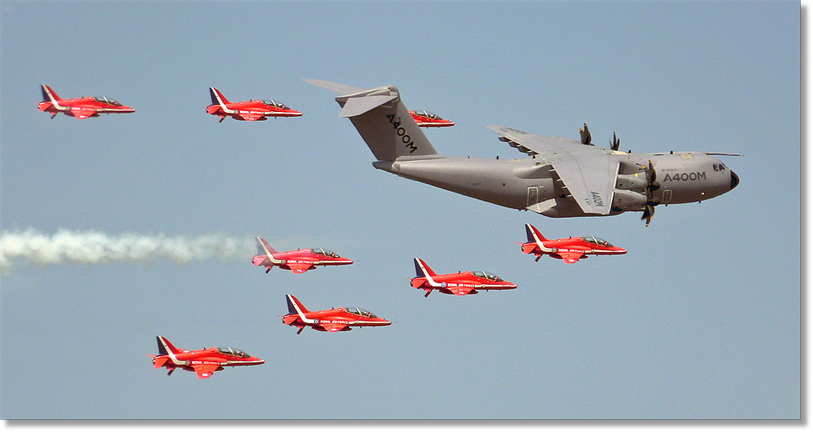
An Airbus Military A400M Atlas flanked by the Royal Air Force Red Arrows display team at the Royal International Air Tattoo, RAF Fairford, earlier this month.
Photograph by Ian Berry.
Photograph by Ian Berry.
From: Bill Girdwood, Carlisle
Sent: Saturday, August 31, 2013 1:50 AM
Subject: Re: UKMAMS OBA OBB #083013
Dear Tony,
As usual, much indebted to you for keeping all the family up-to-date, even if more and more of my colleagues are now dying! Shortly there will be nobody left to enthrall the masses with the details of loading Yorks and completing weight and balance sheets for Hastings!! My God!!
The excitement of it at 0530 on the Calne Strip, rationing the first 2 outbound Hastings of the day, out of the back of my Standard Vanguard pick-up; each night we loaded about 5 outbounds. Great times!
Best regards, as ever,
Bill
Sent: Saturday, August 31, 2013 1:50 AM
Subject: Re: UKMAMS OBA OBB #083013
Dear Tony,
As usual, much indebted to you for keeping all the family up-to-date, even if more and more of my colleagues are now dying! Shortly there will be nobody left to enthrall the masses with the details of loading Yorks and completing weight and balance sheets for Hastings!! My God!!
The excitement of it at 0530 on the Calne Strip, rationing the first 2 outbound Hastings of the day, out of the back of my Standard Vanguard pick-up; each night we loaded about 5 outbounds. Great times!
Best regards, as ever,
Bill
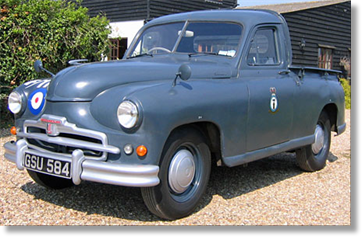
More than 1,000 vehicles return from Afghanistan
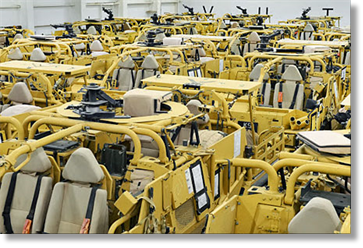
The delivery of nearly 100 vehicles to the UK from Afghanistan today brings the total number redeployed from theatre to more than 1,000.
94 vehicles were unloaded earlier today, Monday 9 September, at Marchwood Sea Mounting Centre near Southampton after transit from a port in the Middle East.
The protected patrol vehicles on board the ‘roll-on, roll-off’ ferry included 18 Mastiffs, each weighing more than 26 tonnes, and more than 30 Jackal vehicles.
94 vehicles were unloaded earlier today, Monday 9 September, at Marchwood Sea Mounting Centre near Southampton after transit from a port in the Middle East.
The protected patrol vehicles on board the ‘roll-on, roll-off’ ferry included 18 Mastiffs, each weighing more than 26 tonnes, and more than 30 Jackal vehicles.
British armoured vehicles are either being flown from Camp Bastion in Helmand province or in some cases moved overland through Pakistan to a sea port, before being loaded onto a ferry. The ferry then spends over 4 weeks at sea navigating through the Gulf of Oman, along the coast of Yemen, across the Red Sea and through the Suez Canal, before sailing through the Mediterranean, past Gibraltar, and finally turning for UK shores.
So far more than 1,080 vehicles and pieces of major equipment have been redeployed to the UK from Afghanistan, alongside 1,570 containers of materiel. Under current plans, around 3,345 vehicles or items of equipment and around 5,500 containers of materiel will be returned by the conclusion of the British combat mission in Afghanistan at the end of 2014. The vehicles returned to the UK today will next travel to the Herrick exchange point facility at Warminster where mechanics will work to bring them up to standard ready to issue to units for future use.
So far more than 1,080 vehicles and pieces of major equipment have been redeployed to the UK from Afghanistan, alongside 1,570 containers of materiel. Under current plans, around 3,345 vehicles or items of equipment and around 5,500 containers of materiel will be returned by the conclusion of the British combat mission in Afghanistan at the end of 2014. The vehicles returned to the UK today will next travel to the Herrick exchange point facility at Warminster where mechanics will work to bring them up to standard ready to issue to units for future use.
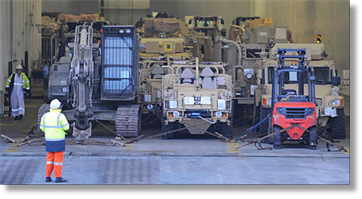
Defence Secretary Philip Hammond said: Having deployed thousands of vehicles and pieces of equipment to Afghanistan over the last 12 years we are making good progress in bringing them home as we near the end of combat operations in December 2014. A huge amount of work goes into returning our equipment and vehicles from Helmand, so I’m pleased with the progress we have made so far. The redeployment of equipment from Afghanistan is a major logistical challenge, but I am confident military planners are up to the task and we are on schedule to bring home the vast array of equipment we have deployed there.
Our troops will be resourced properly to the end of operations, and the drawdown of equipment will not compromise our mission in Afghanistan.
We can only achieve this redeployment because of the successful transition of security control from British forces to Afghan forces, which are increasingly capable and professional. These forces have stepped up in the fight against the insurgency throughout this summer and now lead on security throughout the country.
The Marchwood Sea Mounting Centre is the sole ‘Army’ port in the UK and was built up in 1943 to ferry equipment and personnel to the Normandy beaches the following year during the Second World War. The 289-acre site, which incorporates 3 main jetties, is operated by 17 Port and Maritime Regiment Royal Logistic Corps, who load and discharge Service and civilian shipping in support of military administration, exercises and operations.
Gov.uk
We can only achieve this redeployment because of the successful transition of security control from British forces to Afghan forces, which are increasingly capable and professional. These forces have stepped up in the fight against the insurgency throughout this summer and now lead on security throughout the country.
The Marchwood Sea Mounting Centre is the sole ‘Army’ port in the UK and was built up in 1943 to ferry equipment and personnel to the Normandy beaches the following year during the Second World War. The 289-acre site, which incorporates 3 main jetties, is operated by 17 Port and Maritime Regiment Royal Logistic Corps, who load and discharge Service and civilian shipping in support of military administration, exercises and operations.
Gov.uk
From: Phil Smith, Exmouth
Sent: Monday, September 09, 2013 5:36 AM
Subject: Oz Oswald
After hearing the news regarding Oz`s lung cancer I attempted to contact him, unfortunately without success. I deeply regret not talking to the bloke before he died. From the 13 May when he was diagnosed to 20 Aug when he died, is a frighteningly short period of time.
Along with quite a few others I watched the celebration service via the internet as I was not able to attend. Very sad in parts of course but funny in others. I'm sure he would have laughed at the idea that all the Sunderland Football Club scarves that were worn by a lot of people attending made them look like they were at a Bar Mitzvah ceremony. Well, I thought it did!
A recurring theme during the service was of course booze. However, I have to say when I first met him partial abstinence was the case. During Red Flag late 1981 Oz was in Las Vegas Nevada USA and, as he was not 21 years of age at that time, he was not allowed into any premises that served alcohol, never mind consume the stuff. I do recall a few Harvey Wall Bangers were however whisked out of the bar area and into Oz`s room.
On a weekend trip to Los Angeles I do remember we visited Disney Land in Anaheim and took a ride on Space Mountain. Oz wore his Sunderland FC replica shirt of course much to the amusement of the local Yanks as they were more used to the LA Dodgers. He did try to explain to one of the locals that Roker Park was indeed the centre of the universe and American Baseball was no more than a game of "rounders" played mostly by girls. That went down well.
Oz made up for lost time of course because whenever I bumped into him he was either going to or coming from the FDC Bar in Wildenrath, or indeed in it. It was the same in Carterton, either going to or coming from The Eagle. Or in it.
From 1981 to when I last saw Oz in 2007 I never knew his Christian name was Trevor. No need, Oz was Oz.
He was a good bloke and a good "Mover". Such a shame he died at only 51 years of age.
My sincere condolences are offered to his family.
Phil Smith
Sent: Monday, September 09, 2013 5:36 AM
Subject: Oz Oswald
After hearing the news regarding Oz`s lung cancer I attempted to contact him, unfortunately without success. I deeply regret not talking to the bloke before he died. From the 13 May when he was diagnosed to 20 Aug when he died, is a frighteningly short period of time.
Along with quite a few others I watched the celebration service via the internet as I was not able to attend. Very sad in parts of course but funny in others. I'm sure he would have laughed at the idea that all the Sunderland Football Club scarves that were worn by a lot of people attending made them look like they were at a Bar Mitzvah ceremony. Well, I thought it did!
A recurring theme during the service was of course booze. However, I have to say when I first met him partial abstinence was the case. During Red Flag late 1981 Oz was in Las Vegas Nevada USA and, as he was not 21 years of age at that time, he was not allowed into any premises that served alcohol, never mind consume the stuff. I do recall a few Harvey Wall Bangers were however whisked out of the bar area and into Oz`s room.
On a weekend trip to Los Angeles I do remember we visited Disney Land in Anaheim and took a ride on Space Mountain. Oz wore his Sunderland FC replica shirt of course much to the amusement of the local Yanks as they were more used to the LA Dodgers. He did try to explain to one of the locals that Roker Park was indeed the centre of the universe and American Baseball was no more than a game of "rounders" played mostly by girls. That went down well.
Oz made up for lost time of course because whenever I bumped into him he was either going to or coming from the FDC Bar in Wildenrath, or indeed in it. It was the same in Carterton, either going to or coming from The Eagle. Or in it.
From 1981 to when I last saw Oz in 2007 I never knew his Christian name was Trevor. No need, Oz was Oz.
He was a good bloke and a good "Mover". Such a shame he died at only 51 years of age.
My sincere condolences are offered to his family.
Phil Smith
Afghan Outside the Wire -
Blogspot by Mal Robinson
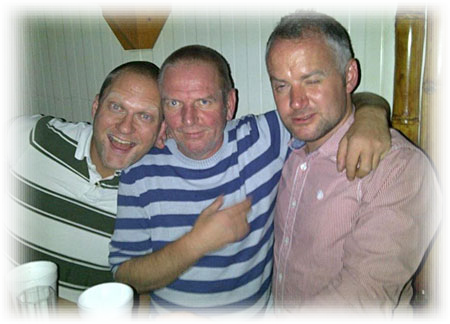
I met Trevor "Oz" Oswald out in Kabul in 2011. In a short space of time we became good mates with the common bond of supporting Sunderland and being in the RAF under the trade of Air Movements.
Here he is seen in the middle of myself (red checked shirt) and Wolfgang our German colleague in the unlicensed bar in Kabul, I won't say where for security and legal reasons!
Tragically, Oz passed away on the 20th of August after a short battle with cancer.
Here he is seen in the middle of myself (red checked shirt) and Wolfgang our German colleague in the unlicensed bar in Kabul, I won't say where for security and legal reasons!
Tragically, Oz passed away on the 20th of August after a short battle with cancer.
Needless to say Oz was a big character in the story of Outside the Wire and whilst my full time job of Managing Director of a media company has got in the way of the book of late (a job Oz secured for me and will feature in the book) I feel now it is time to get back on the keys of the laptop and help highlight what a genuine guy and incredible bloke he was in general and personally for me. I can not believe you have gone mate and I won't be able to call at anytime, however your number kept in my mobile always, the last message never to be deleted.
I have already dedicated the next issue of the magazine Oz became familiar with and also features in a tribute in the new Niall Quinn book we are due to release - he would love that. However, I will leave this entry with a daft story about the man from Trimdon, County Durham.
Oz came over to visit Kabul to teach a Dangerous Goods course to us all. We of course passed this with the help of Oz's incessant knowledge of Logistics, which knew no bounds. We as ex-Movers had been out on the piss all week anyhow, but to show our appreciation of his teaching efforts, we had the old bugger on Gin and Tonic house arrest on his final night in Kabul, Oz not allowed to leave the bar until his drinks were drank (not helped by the endless number of people wanting to buy him a drink such was the impression he made that week to passing people in our group). Oz finally left the bar one hour before he was due to catch his flight from Kabul International Airport on the civilian side - a journey lets just say is not for the faint hearted, so to embark on it fuelled on Gin, was all the more difficult!
Oz never let me forget this and anytime I passed through Dubai be it for a Visa run or returning home to the UK, I was met at arrivals in the UAE and whisked away to the nearest bar within 15 minutes of landing and not allowed to leave until an hour before I was required at the airport! That was Oz for you!
A top top bloke, to whom I owe so much and now always will. I would like to think I have repaid him with my friendship and my share of favours when I could help him out. Thats what mates are for and something the community of ex-forces and in particular ex-Movements just do without question.
Until we meet again Mr. Oswald, I will let you keep that bar seat warm for me.
Sunderland until the end.
Trevor Oz Oswald
1962-2013
I have already dedicated the next issue of the magazine Oz became familiar with and also features in a tribute in the new Niall Quinn book we are due to release - he would love that. However, I will leave this entry with a daft story about the man from Trimdon, County Durham.
Oz came over to visit Kabul to teach a Dangerous Goods course to us all. We of course passed this with the help of Oz's incessant knowledge of Logistics, which knew no bounds. We as ex-Movers had been out on the piss all week anyhow, but to show our appreciation of his teaching efforts, we had the old bugger on Gin and Tonic house arrest on his final night in Kabul, Oz not allowed to leave the bar until his drinks were drank (not helped by the endless number of people wanting to buy him a drink such was the impression he made that week to passing people in our group). Oz finally left the bar one hour before he was due to catch his flight from Kabul International Airport on the civilian side - a journey lets just say is not for the faint hearted, so to embark on it fuelled on Gin, was all the more difficult!
Oz never let me forget this and anytime I passed through Dubai be it for a Visa run or returning home to the UK, I was met at arrivals in the UAE and whisked away to the nearest bar within 15 minutes of landing and not allowed to leave until an hour before I was required at the airport! That was Oz for you!
A top top bloke, to whom I owe so much and now always will. I would like to think I have repaid him with my friendship and my share of favours when I could help him out. Thats what mates are for and something the community of ex-forces and in particular ex-Movements just do without question.
Until we meet again Mr. Oswald, I will let you keep that bar seat warm for me.
Sunderland until the end.
Trevor Oz Oswald
1962-2013
Boeing to end production of military cargo jet
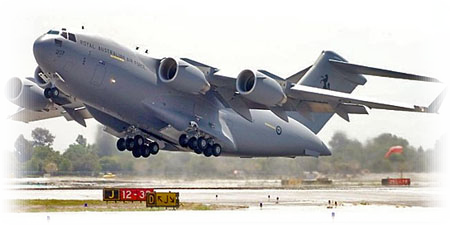
"Our customers around the world face very tough budget environments. While the desire for the C-17's capabilities is high, budgets cannot support additional purchases in the timing required to keep the production line open," Dennis Muilenburg, president and chief executive officer of Boeing Defense, Space & Security, said in a statement. "What's more, here in the United States the sequestration situation has created significant planning difficulties for our customers and the entire aerospace industry."
Last week, the Long Beach plant delivered the last of 223 C-17s produced for the US Air Force. Nan Bouchard, Boeing vice-president and C-17 program manager, said the company will complete 22 final aircraft: seven for the Indian Air Force, two for an international customer that she declined to name, and 13 that have not yet been sold.
"Despite strong international interest, we did not receive sufficient orders [to continue production]," she said.
The Royal Australian Air Force operates six of the highly regarded C-17 aircraft. Delivery of Australia's most recent airlifter was taken by the RAAF Base Amberley, on the outskirts of Ipswich, Queensland, last November.
Boeing said it expects the announcement to result in a charge of less than $100 million this quarter, and that will not impact financial guidance for the year.
The company will begin reducing the C-17 workforce in 2014 at plants in Long Beach; Macon, Georgia; Mesa, Arizona; and St Louis, Missouri. However, Boeing will make efforts to provide jobs elsewhere with the company, Bouchard said, and had plans to continue a repair and spare parts program for the planes through 2017 at least, Bouchard said.
With modernisations and upkeep, the big planes are expected to last for decades, she said.
The massive, four-engine C-17 made its first flight in 1991, and military deliveries began about two years later. The plane is used to airlift tanks, supplies and troops as well as performing medical evacuations. It quickly became a war and disaster workhorse, prized for its ability to operate from basic airstrips and cover intercontinental distances with a full load without refueling.
With a payload of 160,000 pounds, it is designed to airdrop 102 paratroopers and their equipment.
Design work on the plane began at the million-plus square-foot Long Beach facility in 1981, when it was a McDonnell Douglas facility. Boeing merged with McDonnell Douglas in the 1990s. Boeing has so far delivered 257 planes worldwide, at a cost of about $311 million each when research, development and construction costs are included.
The Long Beach plant has about 2000 employees.
"It will be sad that we're closing this last major production facility in Southern California but again, we're all very proud to be part of that heritage," Bouchard said.
Boeing has about 20,000 employees in California, working on a variety of projects. That includes commercial aircraft, new markets such as cyber security and the largest satellite design and manufacturing factory in the world, Boeing said.
The Australian
"Despite strong international interest, we did not receive sufficient orders [to continue production]," she said.
The Royal Australian Air Force operates six of the highly regarded C-17 aircraft. Delivery of Australia's most recent airlifter was taken by the RAAF Base Amberley, on the outskirts of Ipswich, Queensland, last November.
Boeing said it expects the announcement to result in a charge of less than $100 million this quarter, and that will not impact financial guidance for the year.
The company will begin reducing the C-17 workforce in 2014 at plants in Long Beach; Macon, Georgia; Mesa, Arizona; and St Louis, Missouri. However, Boeing will make efforts to provide jobs elsewhere with the company, Bouchard said, and had plans to continue a repair and spare parts program for the planes through 2017 at least, Bouchard said.
With modernisations and upkeep, the big planes are expected to last for decades, she said.
The massive, four-engine C-17 made its first flight in 1991, and military deliveries began about two years later. The plane is used to airlift tanks, supplies and troops as well as performing medical evacuations. It quickly became a war and disaster workhorse, prized for its ability to operate from basic airstrips and cover intercontinental distances with a full load without refueling.
With a payload of 160,000 pounds, it is designed to airdrop 102 paratroopers and their equipment.
Design work on the plane began at the million-plus square-foot Long Beach facility in 1981, when it was a McDonnell Douglas facility. Boeing merged with McDonnell Douglas in the 1990s. Boeing has so far delivered 257 planes worldwide, at a cost of about $311 million each when research, development and construction costs are included.
The Long Beach plant has about 2000 employees.
"It will be sad that we're closing this last major production facility in Southern California but again, we're all very proud to be part of that heritage," Bouchard said.
Boeing has about 20,000 employees in California, working on a variety of projects. That includes commercial aircraft, new markets such as cyber security and the largest satellite design and manufacturing factory in the world, Boeing said.
The Australian
Boeing Co. Has announced that it will end production of its C-17 Globemaster III military cargo jet. It will close the final assembly plant in Long Beach, California, in 2015, putting as many as 3000 jobs at risk as orders plunged in the fragile world economy.
New members who have joined us recently:

RAAF
Andy State, Melbourne, VIC, Australia

RCAF
Bill Maier, Belleville, ON, Canada
Pete Conlin, Aylmer, QC, Canada

RAF
Ed Stout, Stafford, Staffs, UK
Iain Rowlands, Newton Abbot, Devon, UK
Taff Williams, Calne, Wilts, UK
Frank Johnston, Navarre, FL, United States
Patrick Franks, Inverness, UK
Nichola Simmons, Cambois, Northumberland, UK
Bryan Morgan, Abingdon, Oxon, UK
Doug Murray, Torrevieja, Spain
Raymond Hedinburgh, Huntingdon, Cambs, UK
Graham Fitzgerald, Newport, Mon, UK
Tim Ketcher, Braybrooke, Northants, UK
Paul Douse, Ludham, Norfolk, UK
Kit Kitson, Doddington, Cambs, UK
Iain Rowlands, Newton Abbot, Devon, UK
Taff Williams, Calne, Wilts, UK
Frank Johnston, Navarre, FL, United States
Patrick Franks, Inverness, UK
Nichola Simmons, Cambois, Northumberland, UK
Bryan Morgan, Abingdon, Oxon, UK
Doug Murray, Torrevieja, Spain
Raymond Hedinburgh, Huntingdon, Cambs, UK
Graham Fitzgerald, Newport, Mon, UK
Tim Ketcher, Braybrooke, Northants, UK
Paul Douse, Ludham, Norfolk, UK
Kit Kitson, Doddington, Cambs, UK
Richard Evans, Latina, Italy
Garry Fitt, Leeds, West Yorks, UK
Anthony (Taff) Wood, Carterton, Oxon, UK
Russ Carter, Caldercruix, North Lanark, UK
Neil Cutler, Oxford, Oxon, UK
Barry Trudgen, Swindon, Wilts, UK
Stuart Laird, Poole, Dorset, UK
Tony Freeman, Thornhill, Dumfries, UK
John Furney, Al Manama, Bahrain
Barney Fielder, Huntingdon, Cambs, UK
Rod Stone, Abingdon, Oxon, UK
Ray Ralph, Bremen, Germany
Garry Fitt, Leeds, West Yorks, UK
Anthony (Taff) Wood, Carterton, Oxon, UK
Russ Carter, Caldercruix, North Lanark, UK
Neil Cutler, Oxford, Oxon, UK
Barry Trudgen, Swindon, Wilts, UK
Stuart Laird, Poole, Dorset, UK
Tony Freeman, Thornhill, Dumfries, UK
John Furney, Al Manama, Bahrain
Barney Fielder, Huntingdon, Cambs, UK
Rod Stone, Abingdon, Oxon, UK
Ray Ralph, Bremen, Germany
Welcome to the OBA!
Final farewell for VC10s after 50 years
The last two VC10s have been withdrawn from RAF service after more than 50 years of crucial work around the world.
One returned from the Falklands earlier this month. Both were based at RAF Brize Norton in Oxfordshire from where they made a final sortie around the UK last Friday.
VC10s were used wherever British forces were in action, including in Yemen, the Falklands and the first Gulf War.
One returned from the Falklands earlier this month. Both were based at RAF Brize Norton in Oxfordshire from where they made a final sortie around the UK last Friday.
VC10s were used wherever British forces were in action, including in Yemen, the Falklands and the first Gulf War.
They were also used to carry members of the Royal family and politicians overseas.
The aircraft is being replaced by Voyager, an aircraft based on a modified A330 holiday jet that is replacing the VC10 and Tristar.
The prototype of the VC10 plane, G-ARTA, made its maiden flight on June 29, 1962, and the VC10 went on to be used heavily by commercial airlines and the military. At the time the RAF added it to its fleet, it was the heaviest and most powerful aircraft it had used and provided a new global transport capability.
The last of the planes were in service with 101 Squadron, based at RAF Brize Norton, Oxfordshire, pending their retirement.
Over the last half century the VC10 has been involved in many major international crises.
It was used to bring British troops back from Aden, Yemen, in 1967 - the biggest operation of its type since the Berlin airlift.
In February 1979, RAF VC10s and C-130s flew 650 men, women and children out of Iran in four days - moving the Daily Express to comment: "RAF ... the airline you can trust."
In the Falklands War in 1982, the first task of the VC10 was to fly the islands' governor, Rex Hunt, and the 61 Marines of the Naval Party 8901 from the airport of Montevideo in neutral Uruguay.
The VC10 was soon involved in the evacuation of the seriously wounded from Montevideo. Two VC10s were painted with the international markings of the Red Cross and permitted to carry 65 wounded. The aircraft carried more than 400 casualties by this route, which involved a 24-hour flight with a refuelling stop at Ascension Island.
During the first Gulf War, VC10s flew air-to-air refuelling missions and more than 5,000 hours of supply and medical duties.
The VC10 has also been involved in operations in Afghanistan, refuelling British and US aircraft.
The first royal flight by an RAF VC10 was the journey to Australia and back by the Prince of Wales, Harold Wilson and Ted Heath in 1967 for the memorial service for the Australian premier Harold Holt, who drowned while swimming.
The flight from London to Melbourne took 21 hours, 46 minutes including two stops at Muharraq in Bahrain and Gan in the Indian Ocean. Civil aircraft took 36 hours at that time to complete the journey.
The VC10 was used for the Queen's bicentennial tour of America. On July 3, 1976, the Queen and the Duke of Edinburgh embarked on a tour of the USA with the first stop in Bermuda.
Prime minister Tony Blair was on board the last VC10 to complete an approach to Kai Tak airport in Hong Kong on June 29, 1997. He was attending the handover ceremonies of the British colony to China.
Politicians have had varying opinions of the VC10 - Margaret Thatcher always insisted on using the aircraft, but John Major hated its outdated air-conditioning system, preferring Concorde or a Boeing 747.
In 1998 a set of divan sofa-beds were added to a VC10 used by Mr Blair at a cost of £50,000 so the premier, his wife and aides could sleep during flights.
The VC10 was a great favourite of Mrs Thatcher. Her office on board was curtained off for extra privacy and she had her own steward to pour drinks, whiskey or mineral water, with a glass of red wine with meals.
Denis Thatcher was also often on board. He enjoyed a quiet gin and tonic and sometimes went to the back of the plane to talk to the "reptiles" - his nickname for journalists.
On August 1, 1990, Mrs Thatcher was presented with a log book to commemorate her 1,000 hours of flying on a VC10.
Freed hostages John McCarthy and Terry Waite flew home by VC10 in 1991 after years of being held in Beirut.
British Forces News
The aircraft is being replaced by Voyager, an aircraft based on a modified A330 holiday jet that is replacing the VC10 and Tristar.
The prototype of the VC10 plane, G-ARTA, made its maiden flight on June 29, 1962, and the VC10 went on to be used heavily by commercial airlines and the military. At the time the RAF added it to its fleet, it was the heaviest and most powerful aircraft it had used and provided a new global transport capability.
The last of the planes were in service with 101 Squadron, based at RAF Brize Norton, Oxfordshire, pending their retirement.
Over the last half century the VC10 has been involved in many major international crises.
It was used to bring British troops back from Aden, Yemen, in 1967 - the biggest operation of its type since the Berlin airlift.
In February 1979, RAF VC10s and C-130s flew 650 men, women and children out of Iran in four days - moving the Daily Express to comment: "RAF ... the airline you can trust."
In the Falklands War in 1982, the first task of the VC10 was to fly the islands' governor, Rex Hunt, and the 61 Marines of the Naval Party 8901 from the airport of Montevideo in neutral Uruguay.
The VC10 was soon involved in the evacuation of the seriously wounded from Montevideo. Two VC10s were painted with the international markings of the Red Cross and permitted to carry 65 wounded. The aircraft carried more than 400 casualties by this route, which involved a 24-hour flight with a refuelling stop at Ascension Island.
During the first Gulf War, VC10s flew air-to-air refuelling missions and more than 5,000 hours of supply and medical duties.
The VC10 has also been involved in operations in Afghanistan, refuelling British and US aircraft.
The first royal flight by an RAF VC10 was the journey to Australia and back by the Prince of Wales, Harold Wilson and Ted Heath in 1967 for the memorial service for the Australian premier Harold Holt, who drowned while swimming.
The flight from London to Melbourne took 21 hours, 46 minutes including two stops at Muharraq in Bahrain and Gan in the Indian Ocean. Civil aircraft took 36 hours at that time to complete the journey.
The VC10 was used for the Queen's bicentennial tour of America. On July 3, 1976, the Queen and the Duke of Edinburgh embarked on a tour of the USA with the first stop in Bermuda.
Prime minister Tony Blair was on board the last VC10 to complete an approach to Kai Tak airport in Hong Kong on June 29, 1997. He was attending the handover ceremonies of the British colony to China.
Politicians have had varying opinions of the VC10 - Margaret Thatcher always insisted on using the aircraft, but John Major hated its outdated air-conditioning system, preferring Concorde or a Boeing 747.
In 1998 a set of divan sofa-beds were added to a VC10 used by Mr Blair at a cost of £50,000 so the premier, his wife and aides could sleep during flights.
The VC10 was a great favourite of Mrs Thatcher. Her office on board was curtained off for extra privacy and she had her own steward to pour drinks, whiskey or mineral water, with a glass of red wine with meals.
Denis Thatcher was also often on board. He enjoyed a quiet gin and tonic and sometimes went to the back of the plane to talk to the "reptiles" - his nickname for journalists.
On August 1, 1990, Mrs Thatcher was presented with a log book to commemorate her 1,000 hours of flying on a VC10.
Freed hostages John McCarthy and Terry Waite flew home by VC10 in 1991 after years of being held in Beirut.
British Forces News
From: Bob Pountney, Forres, Moray
Sent: Friday, August 30, 2013 1:29 PM
Subject: VC10 Whisky
Hi Tony,
As if I didn't have enough to fill in my retirement time I find myself as an unpaid Director of Morayvia (see link below).
Apart from donations given by the public to look around our Nimrod fuselage and a small income from the shop we set up at events we are always looking at other methods and the latest is a limited edition malt whisky to mark the passing of the VC10 in military service.
A Glen Moray 10 year old single Malt, it is a single cask, cask strength, 61% proof, hand drawn from a single Bourbon cask and comes in a special box with accompanying numbered certificate and descriptive tri-fold describing the VC10 in military service.
The edition numbers 242 and will not be repeated. All the bottles were flown in VC10 ZA147 from Lossiemouth to Brize Norton and returned in a Hercules.
The price is £90 plus p&p and there are a very limited number of aircraft related numbers e.g 147 for ZA147 which sell at £125 inc p&p.
The proceeds from this issue will be divided equally between Morayvia and the RAF Benevolent Fund, chosen because the single service charities are suffering from the success of HFH.
Tony, it would be great if you could publicise this sale on your MAMS website and I have attached a poster which is self explanatory.
Hope all is well with you and yours on that side of the pond and keep up the great work.
Best wishes
Bob
http://www.morayvia.org.uk/
Sent: Friday, August 30, 2013 1:29 PM
Subject: VC10 Whisky
Hi Tony,
As if I didn't have enough to fill in my retirement time I find myself as an unpaid Director of Morayvia (see link below).
Apart from donations given by the public to look around our Nimrod fuselage and a small income from the shop we set up at events we are always looking at other methods and the latest is a limited edition malt whisky to mark the passing of the VC10 in military service.
A Glen Moray 10 year old single Malt, it is a single cask, cask strength, 61% proof, hand drawn from a single Bourbon cask and comes in a special box with accompanying numbered certificate and descriptive tri-fold describing the VC10 in military service.
The edition numbers 242 and will not be repeated. All the bottles were flown in VC10 ZA147 from Lossiemouth to Brize Norton and returned in a Hercules.
The price is £90 plus p&p and there are a very limited number of aircraft related numbers e.g 147 for ZA147 which sell at £125 inc p&p.
The proceeds from this issue will be divided equally between Morayvia and the RAF Benevolent Fund, chosen because the single service charities are suffering from the success of HFH.
Tony, it would be great if you could publicise this sale on your MAMS website and I have attached a poster which is self explanatory.
Hope all is well with you and yours on that side of the pond and keep up the great work.
Best wishes
Bob
http://www.morayvia.org.uk/
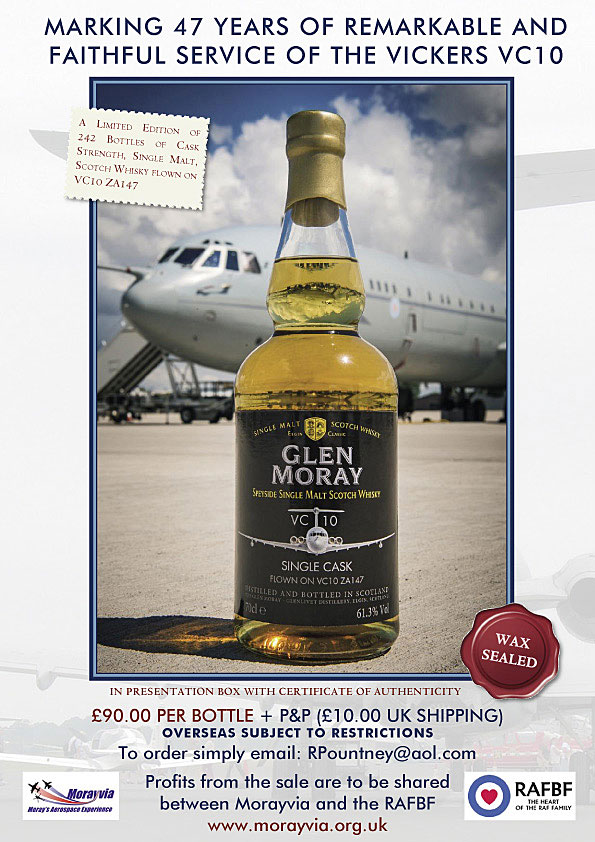
First A400M wings for Royal Air Force leave for final assembly line
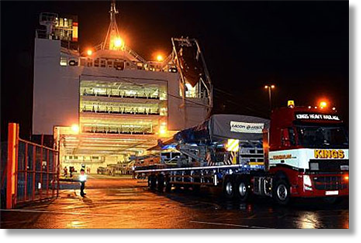
AIRCRAFT wings assembled in Filton have been shipped to Spain ready for use on the first Royal Air Force A400M military transporter.
The wings have been put together by highly skilled employees at Airbus.
Following the closure of Filton airfield last year, the wings are being transported to a final assembly line in Seville by road and sea, being loaded onto a ferry at the Royal Portbury Docks, Bristol.
The wings have been put together by highly skilled employees at Airbus.
Following the closure of Filton airfield last year, the wings are being transported to a final assembly line in Seville by road and sea, being loaded onto a ferry at the Royal Portbury Docks, Bristol.
The RAF is expecting to receive the first of its order of 22 A400Ms airlifters next September, which are set to replace the current ageing Hercules fleet.
In March Airbus announced 50 temporary jobs were being created at Filton to assist production after an increase in A400M orders.
The model’s development has been dogged by delays, overspends and political rows. Its maiden flight, originally planned for 2008, took place in December 2009.
Orders totalled 174 aircraft from eight nations as of July 2011 and the first A400M was delivered to the French Air Force in August.
Airbus employs around 4,500 staff at its factory in Filton, which has built aircraft from the Brabazon to Concorde and most recently the A380, the world's largest commercial aircraft.
Airbus Military
In March Airbus announced 50 temporary jobs were being created at Filton to assist production after an increase in A400M orders.
The model’s development has been dogged by delays, overspends and political rows. Its maiden flight, originally planned for 2008, took place in December 2009.
Orders totalled 174 aircraft from eight nations as of July 2011 and the first A400M was delivered to the French Air Force in August.
Airbus employs around 4,500 staff at its factory in Filton, which has built aircraft from the Brabazon to Concorde and most recently the A380, the world's largest commercial aircraft.
Airbus Military
From: John Bell, Desborough
Sent: Saturday, August 31, 2013 11:31 AM
Subject: Wartime SOE
Tony,
Just read the old bods magazine article on the talk on the SOE. Coincidentally I was just going out the door to visit an old wartime airfield near where I live, RAF Harrington. There is a small museum there that contains paraphernalia used in the deployment and recovery of SOE agents during WW2. They also show a short film on the wartime SOE operations, quite interesting.
The base was used at different times by the RAF and the USAAF (Note the double A). It was obviously a secret location and unusual measures were taken to prevent disclosure. Agents were not made aware of the location of the airfield and staff at the airfield were not allowed to talk to the agents except when it related to their prepping up for a para jump or air landing.
Sent: Saturday, August 31, 2013 11:31 AM
Subject: Wartime SOE
Tony,
Just read the old bods magazine article on the talk on the SOE. Coincidentally I was just going out the door to visit an old wartime airfield near where I live, RAF Harrington. There is a small museum there that contains paraphernalia used in the deployment and recovery of SOE agents during WW2. They also show a short film on the wartime SOE operations, quite interesting.
The base was used at different times by the RAF and the USAAF (Note the double A). It was obviously a secret location and unusual measures were taken to prevent disclosure. Agents were not made aware of the location of the airfield and staff at the airfield were not allowed to talk to the agents except when it related to their prepping up for a para jump or air landing.
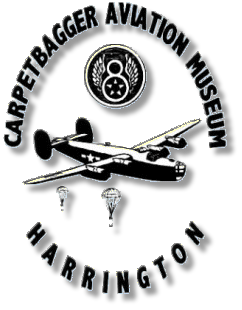
Known as OPERATION CARPETBAGGER, a popular myth was that the agents would arrive at the base carrying carpet bags. Not so. More likely to refer to their method of carrying items in France or where ever they landed. To quote from a pamphlet on the operation: Personnel to be dropped into enemy territory usually arrived in large American cars with curtained windows. The strictest security was observed during this period. They were taken to the “dressing huts”, where they were searched for any tell-tale objects. They were then helped into large padded jump suits and rubber helmets. During this time no one except the OSS (The American Military Intelligence Department known as the Office of Strategic Services) dressers were allowed to talk to them.
The museum has a web site at Carpetbagger Aviation Museum. It's located near Kettering and worth a visit if you are in that area. (Open weekends until the end of October.)
John Bell
The museum has a web site at Carpetbagger Aviation Museum. It's located near Kettering and worth a visit if you are in that area. (Open weekends until the end of October.)
John Bell
From: Don Hazlewood
Sent: Saturday, September 07, 2013 4:54 AM
Subject: Maggie's trip
Tony,
To go with the cost of Maggie’s trip, a copy of the thank you letter.
Surprising what some people keep!
Rgds Don
Sent: Saturday, September 07, 2013 4:54 AM
Subject: Maggie's trip
Tony,
To go with the cost of Maggie’s trip, a copy of the thank you letter.
Surprising what some people keep!
Rgds Don
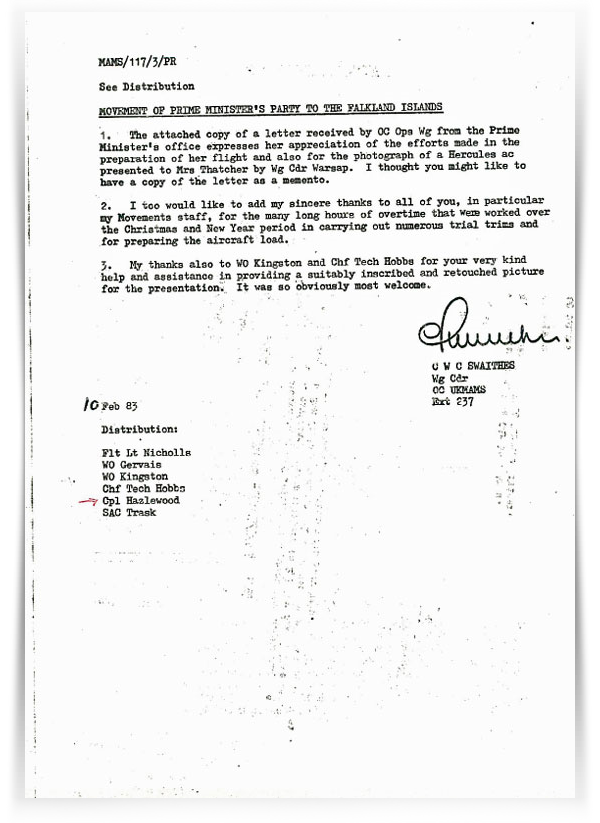
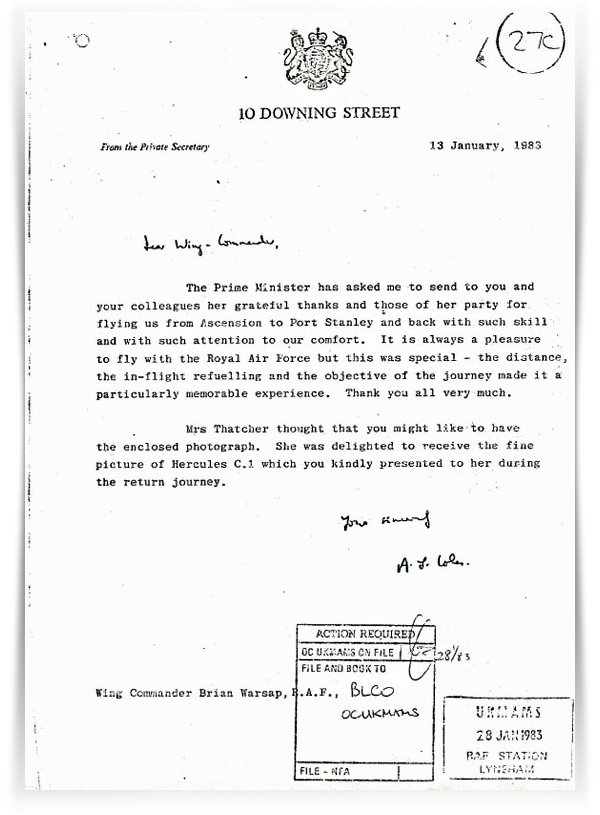
From: Charles Collier, Ewhurst
Sent: Friday, August 30, 2013 4:15 PM
Subject: The War That Never Was
Hi Tony,
The book here entitled “The War that never was” is another of a very scarce band of historical writings about happenings in the British Colony of Aden during our presence there in the late 1960’s. Basically, what this book describes is the covert war utilising “special forces” - operating on their own without Governmental sanction - and local royalist tribesmen with the aim of destroying President Nasser’s ambitions of invading the whole of South Arabia. As the book describes, Nasser, in the end, was compelled to admit that the Yemen had been his Vietnam!
So, if you were in Aden any time from 1962 to the end in 1967 this is the book to read. If it helps I got my book from the library. Now, also, if you also remember “The Radfan War, which happened at the same time that this book covers, except that in the Radfan it was overt in that it utilised Government sanctioned British troops and air support. The conjoint effort by the two forces working independently of each other secured South Arabia from aggressive alien hands whilst we remained there!
All the best to you all
Charles P Collier
AKA Chas
Sent: Friday, August 30, 2013 4:15 PM
Subject: The War That Never Was
Hi Tony,
The book here entitled “The War that never was” is another of a very scarce band of historical writings about happenings in the British Colony of Aden during our presence there in the late 1960’s. Basically, what this book describes is the covert war utilising “special forces” - operating on their own without Governmental sanction - and local royalist tribesmen with the aim of destroying President Nasser’s ambitions of invading the whole of South Arabia. As the book describes, Nasser, in the end, was compelled to admit that the Yemen had been his Vietnam!
So, if you were in Aden any time from 1962 to the end in 1967 this is the book to read. If it helps I got my book from the library. Now, also, if you also remember “The Radfan War, which happened at the same time that this book covers, except that in the Radfan it was overt in that it utilised Government sanctioned British troops and air support. The conjoint effort by the two forces working independently of each other secured South Arabia from aggressive alien hands whilst we remained there!
All the best to you all
Charles P Collier
AKA Chas
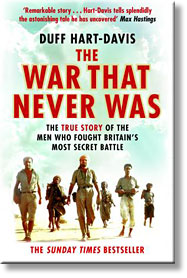
The Royal Australian Air Force (RAAF) has bid a final farewell to its last remaining F-111, which is being taken from Amberley base, west of Brisbane, to Hawaii.
The much-loved fighter jet had its wings clipped ahead of its last journey to the Pacific Air Museum at Pearl Harbour.
The much-loved fighter jet had its wings clipped ahead of its last journey to the Pacific Air Museum at Pearl Harbour.
Air Force bids farewell to final F-111
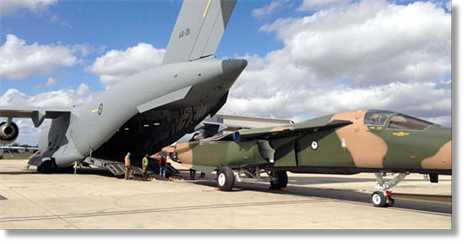
"It's quite an historic day from an Air Force perspective particularly for the guys who've worked on the F-111... to see the last one just about to depart," said Wing Commander Clive Wells, who has managed the disposal of all the Air Force's F-111s.
The RAAF originally purchased 43 F-111s.
Eight crashed, 23 were buried, and the remainder have been put on display in defence establishments and museums around Australia.
They were known for their ability to get down low and fast for bombing runs, earning the nickname "the pig".
The final F-111 has been stripped down and is being carried as cargo inside a C-17 to Honolulu. Wing Commander Paul Long, who is flying the cargo plane, says it has been a massive logistical task to get the fighter jet ready to fly as a passenger.
The RAAF originally purchased 43 F-111s.
Eight crashed, 23 were buried, and the remainder have been put on display in defence establishments and museums around Australia.
They were known for their ability to get down low and fast for bombing runs, earning the nickname "the pig".
The final F-111 has been stripped down and is being carried as cargo inside a C-17 to Honolulu. Wing Commander Paul Long, who is flying the cargo plane, says it has been a massive logistical task to get the fighter jet ready to fly as a passenger.
"When we flew over Brisbane, schools emptied so that the kids could have a look.
"People still talk to me about how they remember what they were doing on June 1, 1973 - and it was watching the F-111s fly over."
The F-111s are best known around south-east Queensland for their participation in the annual Riverfire display.
"They were a great party animal for their dump and burns and I guess that's what they're best remembered for," Wing Commander Wells said.
The famous fighter jets were officially retired in 2010, and have been replaced by the more modern and capable Super Hornets.
ABC News
"People still talk to me about how they remember what they were doing on June 1, 1973 - and it was watching the F-111s fly over."
The F-111s are best known around south-east Queensland for their participation in the annual Riverfire display.
"They were a great party animal for their dump and burns and I guess that's what they're best remembered for," Wing Commander Wells said.
The famous fighter jets were officially retired in 2010, and have been replaced by the more modern and capable Super Hornets.
ABC News
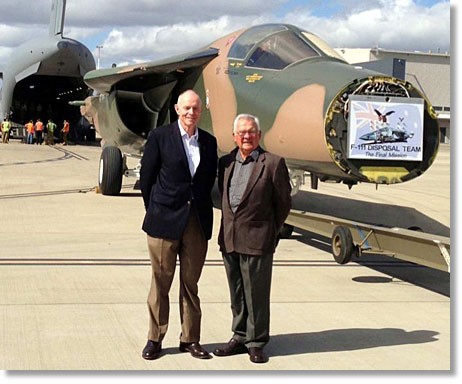
Former RAAF pilots Peter Growder (left) and Bob Sivyer
"It's the first time it's ever been done by the Royal Australian Air Force and probably by anybody for that matter," he said. "It's taken a lot of effort by people to weigh the aeroplane, measure it, determine the tie-down points and determine how to carry it," said the commanding officer of the RAAF 36th Squadron. "The actual fuselage we're loading today is about 38,000 pounds (17,200kg)."
Watching the old warhorse prepare for her last mission was bittersweet for former Flight Lieutenant Bob Sivyer. The 69-year old flew the aircraft to Australia from the United States in 1973. "We travelled from Sacramento to Honolulu, then travelled to Pago Pago where we had a day's rest before doing the final leg," he said. "Magic aeroplane, absolutely the best I've flown."
Retired Air Commodore Peter Growder was also onboard that first flight. "We were very thrilled to be part of history," he said.
Watching the old warhorse prepare for her last mission was bittersweet for former Flight Lieutenant Bob Sivyer. The 69-year old flew the aircraft to Australia from the United States in 1973. "We travelled from Sacramento to Honolulu, then travelled to Pago Pago where we had a day's rest before doing the final leg," he said. "Magic aeroplane, absolutely the best I've flown."
Retired Air Commodore Peter Growder was also onboard that first flight. "We were very thrilled to be part of history," he said.
From: David Powell, Princes Risborough
Sent: Wednesday, September 04, 2013 6:35 AM
Subject: Re: UKMAMS OBA OBB #083013
Hi Tony
So very sorry to learn of the final departure of Sqn Ldr 'Boss' Bill Jacobs. He was our leader during my time with F team at Abingdon, and it was a privilege to work for him, aided and abetted as he was by that unforgettable character and fellow Scot, Flt Lt Jock McKay in Ops.
Best wishes to all of you out there.
David Powell F Team 1967-69
Sent: Wednesday, September 04, 2013 6:35 AM
Subject: Re: UKMAMS OBA OBB #083013
Hi Tony
So very sorry to learn of the final departure of Sqn Ldr 'Boss' Bill Jacobs. He was our leader during my time with F team at Abingdon, and it was a privilege to work for him, aided and abetted as he was by that unforgettable character and fellow Scot, Flt Lt Jock McKay in Ops.
Best wishes to all of you out there.
David Powell F Team 1967-69
From: John Bell, Desborough
Sent: Saturday, August 31, 2013 11:52 AM
Subject: Jack Hobbs
Tony,
It was sad to read that Sqn Ldr (Rtd) Bill Jacobs had died in June. He certainly had a good innings.
The reference to his nickname of Jack Hobbs reminds me of an incident not long after I joined the squadron. I was away on task and, as was often the case, our return was delayed. Bill Jacobs took it on himself to advise the families of this delay.
When he came around to the married quarters and told my wife, her response was (having only ever heard me and other Sqn members refer to the boss as Jack Hobbs), “Thank you Mr Hobbs.” Jean remembers that he smiled but at the time she did not understand why.
I remember him as a guy who was keenly interested in the welfare of his “troops.” I can think of a couple of occasions when he insisted with the RAF Records Office that replacement NCOs into MAMS had to be promotions from within the squadron.
RIP Boss.
John Bell
Sent: Saturday, August 31, 2013 11:52 AM
Subject: Jack Hobbs
Tony,
It was sad to read that Sqn Ldr (Rtd) Bill Jacobs had died in June. He certainly had a good innings.
The reference to his nickname of Jack Hobbs reminds me of an incident not long after I joined the squadron. I was away on task and, as was often the case, our return was delayed. Bill Jacobs took it on himself to advise the families of this delay.
When he came around to the married quarters and told my wife, her response was (having only ever heard me and other Sqn members refer to the boss as Jack Hobbs), “Thank you Mr Hobbs.” Jean remembers that he smiled but at the time she did not understand why.
I remember him as a guy who was keenly interested in the welfare of his “troops.” I can think of a couple of occasions when he insisted with the RAF Records Office that replacement NCOs into MAMS had to be promotions from within the squadron.
RIP Boss.
John Bell
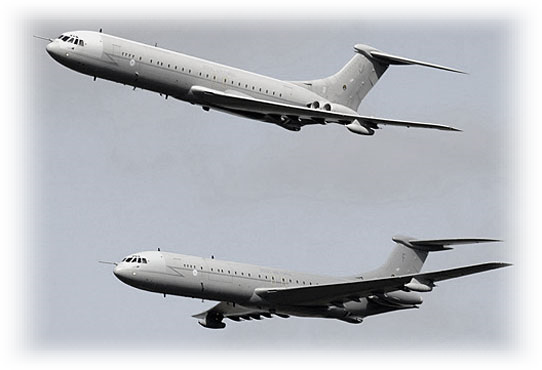
Exercise Precision Red-Combat Training
By LAC Aimee Wright
Nine Royal New Zealand Air Force personnel deployed to Townsville on 18 June 2010 to participate in the Royal Australian Air Force (RAAF) Exercise Precision Red 2010. The Exercise enabled C-130 J Hercules pilots and aircrew to gain combat training and qualifications in preparation for deployment to the Middle East. It also provided the RNZAF Air Terminal Units a chance to learn new skills and how to operate under pressure and in harsher conditions. Leading Aircraftman Aimee Wright was there.
When we first arrived in Townsville five days were spent standardising our procedures with the Australians and learning some new ‘tricks’. We also managed to fit in some hard out Physical Training (PT) sessions by the pool.
From Townsville we left on a C-130 J Hercules to Rockhampton where the rest of our Australian contingent (23 personnel) were waiting to convey us into our home for the next two weeks-Sam Hill Airfield. Heavy rain greeted our day of set-up, but this didn’t faze ‘us Kiwis’! Within two days, we had created a fully operational air movements terminal, complete with air to ground communications, an operations tent, a passenger tent and even a ‘Joe room’ area to rest between flights.
Four days into our Exercise we went live, with flights starting on 28 June. From here we were into it with Engine Running On Loads and Off Loads (ERO’s). Most of the team had never been a part of ERO’s before so that in itself was an experience, but on top of that we were delivered with a lot of unexpected situations. Flights would turn up with next to no notification with on loads and off loads changing meaning we had to be flexible, ready to move and fill in any role as things came up.
We got stuck into all aspects of running an Air Movements Terminal, with a load team out on the tarmac and an operations team in charge of all communication and paperwork. This also meant we all had to be retrained in our Radio (RATEL) discipline and procedures.
During this first week of the Exercise we learned the importance of being proactive so that we could respond quickly. Communicating with each other was crucial, otherwise there was potential for operations to fall apart.
On top of our daily operations, PT was a must. Every morning at 0630hrs, before we started our working day, we were up and running-literally! It proved to be one of the best parts of our day-and we got to show the Aussies ‘what we Kiwis are made of’!
We all adapted well to the Aussie life style and managed to glean some of the Aussie’s Air Movements tricks. We headed home from the Exercise with a lot more experience and confidence in what we do and how much we already know. More importantly, we showed our Anzac buddies what a fun but professional and adaptable team the RNZAF sent over.
airforce.mil.nz
By LAC Aimee Wright
Nine Royal New Zealand Air Force personnel deployed to Townsville on 18 June 2010 to participate in the Royal Australian Air Force (RAAF) Exercise Precision Red 2010. The Exercise enabled C-130 J Hercules pilots and aircrew to gain combat training and qualifications in preparation for deployment to the Middle East. It also provided the RNZAF Air Terminal Units a chance to learn new skills and how to operate under pressure and in harsher conditions. Leading Aircraftman Aimee Wright was there.
When we first arrived in Townsville five days were spent standardising our procedures with the Australians and learning some new ‘tricks’. We also managed to fit in some hard out Physical Training (PT) sessions by the pool.
From Townsville we left on a C-130 J Hercules to Rockhampton where the rest of our Australian contingent (23 personnel) were waiting to convey us into our home for the next two weeks-Sam Hill Airfield. Heavy rain greeted our day of set-up, but this didn’t faze ‘us Kiwis’! Within two days, we had created a fully operational air movements terminal, complete with air to ground communications, an operations tent, a passenger tent and even a ‘Joe room’ area to rest between flights.
Four days into our Exercise we went live, with flights starting on 28 June. From here we were into it with Engine Running On Loads and Off Loads (ERO’s). Most of the team had never been a part of ERO’s before so that in itself was an experience, but on top of that we were delivered with a lot of unexpected situations. Flights would turn up with next to no notification with on loads and off loads changing meaning we had to be flexible, ready to move and fill in any role as things came up.
We got stuck into all aspects of running an Air Movements Terminal, with a load team out on the tarmac and an operations team in charge of all communication and paperwork. This also meant we all had to be retrained in our Radio (RATEL) discipline and procedures.
During this first week of the Exercise we learned the importance of being proactive so that we could respond quickly. Communicating with each other was crucial, otherwise there was potential for operations to fall apart.
On top of our daily operations, PT was a must. Every morning at 0630hrs, before we started our working day, we were up and running-literally! It proved to be one of the best parts of our day-and we got to show the Aussies ‘what we Kiwis are made of’!
We all adapted well to the Aussie life style and managed to glean some of the Aussie’s Air Movements tricks. We headed home from the Exercise with a lot more experience and confidence in what we do and how much we already know. More importantly, we showed our Anzac buddies what a fun but professional and adaptable team the RNZAF sent over.
airforce.mil.nz
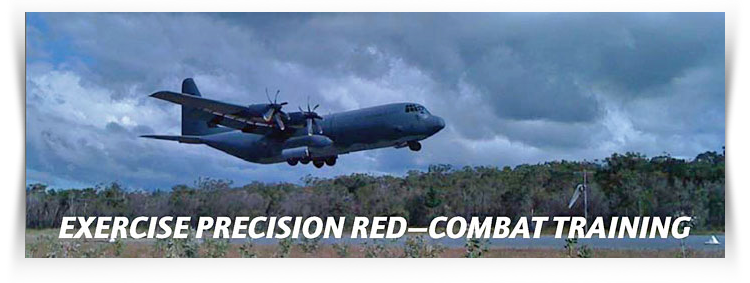
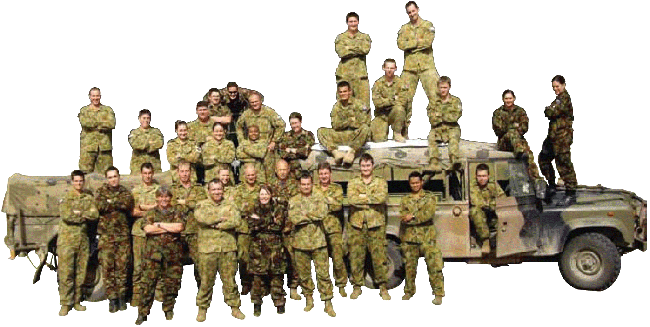
From: Tony Street, Buffalo, NY
Sent: Saturday, September 07, 2013 10:04 AM
Subject: Evil Spirits
Sent: Saturday, September 07, 2013 10:04 AM
Subject: Evil Spirits
In 1965, I was flying as a Yukon Loadmaster on 437(T) Squadron out of RCAF Station Trenton.
Our mission was to fly to Ottawa and pick up 125 Air Cadets and fly them to Jamaica and bring 125 Jamaican cadets back to Ottawa on an exchange program.
We arrived in Ottawa and loaded the kids on board and were introduced to the escorting officer, an officious army Captain who immediately irritated everyone by his overbearing boorishness and penchant for telling everyone how to do their job.
He was well turned out with a ramrod spine, knifelike creases in his uniform, short haircut, jutting chin etc. He affected the British Army’s long and pointy waxed mustache (A thing of ridiculous beauty), along with a bad and assumed English accent. A Sandhurst wannabe.
He was also a graduate of “Swagger Stick School,” and punctuated all his words with rhythmic waving of his penile extension.
Our mission was to fly to Ottawa and pick up 125 Air Cadets and fly them to Jamaica and bring 125 Jamaican cadets back to Ottawa on an exchange program.
We arrived in Ottawa and loaded the kids on board and were introduced to the escorting officer, an officious army Captain who immediately irritated everyone by his overbearing boorishness and penchant for telling everyone how to do their job.
He was well turned out with a ramrod spine, knifelike creases in his uniform, short haircut, jutting chin etc. He affected the British Army’s long and pointy waxed mustache (A thing of ridiculous beauty), along with a bad and assumed English accent. A Sandhurst wannabe.
He was also a graduate of “Swagger Stick School,” and punctuated all his words with rhythmic waving of his penile extension.
The female flight attendants immediately dubbed him “Captain Dipstick” which quickly morphed into “Captain Dip Shit,” And then to “CDS” (Chef of Defense Staff). He went on to tell the troops how to load the baggage, questioned the A/C Commander re the validity of his flight plan and asked if we could, “Swing by Niagara Falls, so the boys can have a look.” He got the “Sit-down-shut-up-and keep your feet off the seats” look from the flight attendants.
Upon arrival in Jamaica it was as dark as the inside of a cow with a temperature of 85 degrees and high humidity. The Air Canada handlers marshaled us into a parking area and hooked up the ground power. CDS was first ashore and was met by the third secretary of the High Commission. They chatted as the large air conditioned busses arrived to pickup the kids. CDS took command. “OK boys,” he whinged, “everybody off the plane and onto the busses while I see to your baggage, hurry up lads as I have just been invited by the third secretary to an exclusive "Jump Up" at the hotel!” Dutifully, the boys boarded the busses, allowing the CDS to now rivet his full attention to the baggage.
Two of the locals who worked for Air Canada had crawled up into the front belly and were slowly but methodically passing out the bags one by one. “Can’t you work faster, men, we’ll be here all night!” cried the Captain.
The reply came in the familiar Caribbean lilt, “We gonna be here all night anyway, Mon, it make no difference to us.” was the reply.
“Let’s get more workers out here then.” suggested CDS.
Upon arrival in Jamaica it was as dark as the inside of a cow with a temperature of 85 degrees and high humidity. The Air Canada handlers marshaled us into a parking area and hooked up the ground power. CDS was first ashore and was met by the third secretary of the High Commission. They chatted as the large air conditioned busses arrived to pickup the kids. CDS took command. “OK boys,” he whinged, “everybody off the plane and onto the busses while I see to your baggage, hurry up lads as I have just been invited by the third secretary to an exclusive "Jump Up" at the hotel!” Dutifully, the boys boarded the busses, allowing the CDS to now rivet his full attention to the baggage.
Two of the locals who worked for Air Canada had crawled up into the front belly and were slowly but methodically passing out the bags one by one. “Can’t you work faster, men, we’ll be here all night!” cried the Captain.
The reply came in the familiar Caribbean lilt, “We gonna be here all night anyway, Mon, it make no difference to us.” was the reply.
“Let’s get more workers out here then.” suggested CDS.
“We de only workers on de shif, you want more workers you go into town an gettem, Mon, take you about two hours der an' back,” was their response.
Just then, the ground power unit ran out of fuel and all the aircraft lights went out and the hydraulics purred to a stop. The only light available was provided by the headlights of the busses parked by the terminal awaiting the baggage. The baggage handlers quit. They moved to the belly door where they could sit upright and swing their legs. Then in strict breach of safety regs, lit up what appeared to be cigarettes but certainly didn’t smell like them. “What are you doing?” shouted the Captain “Get back in the belly and unload the baggage by feel!”
One of the gentleman replied, “Mon, widout de lights in de belly, the belly be full a evil spirits!”
“By God!” roared the now, nearly apoplectic CDS, “This is 1965, there are NO evil spirits in the damned belly. “There’s nothing in the dark that isn’t there in the light, ergo, there are no evil spirits!” he reasoned, “Now, damn it, chaps, crawl into the belly and start passing out the bags!”
Casually sitting in the belly door swinging their legs and grinning from ear to ear, thoroughly enjoying CDS’s discomfort, the Jamaican worker replied, “Mon, widout lights in de belly, da belly sure is fulla dem evil spirits. We have de smash head evil spirit, de smash kneecap evil spirit an de smash elbow evil spirit! Beside dat,” he concluded, “De safety Mon say, no light in de belly, no work in de belly!”
With at least two or more hours to get the GPU fueled and the bags loaded into the busses, we buttoned up the rest of the aircraft and left the problem in the capable hands of Air Canada and headed to our hotel.
Upon checking in, each crewmember was handed an invitation to a “Poolside Jump-Up” hosted by the Canadian High Commissioner who seldom showed for these shindigs. They were held to let the embassy staff visit with folks from home and enjoy catching up. In Africa, these parties were called Sundowners. I have been to several and all are very informal.
Just then, the ground power unit ran out of fuel and all the aircraft lights went out and the hydraulics purred to a stop. The only light available was provided by the headlights of the busses parked by the terminal awaiting the baggage. The baggage handlers quit. They moved to the belly door where they could sit upright and swing their legs. Then in strict breach of safety regs, lit up what appeared to be cigarettes but certainly didn’t smell like them. “What are you doing?” shouted the Captain “Get back in the belly and unload the baggage by feel!”
One of the gentleman replied, “Mon, widout de lights in de belly, the belly be full a evil spirits!”
“By God!” roared the now, nearly apoplectic CDS, “This is 1965, there are NO evil spirits in the damned belly. “There’s nothing in the dark that isn’t there in the light, ergo, there are no evil spirits!” he reasoned, “Now, damn it, chaps, crawl into the belly and start passing out the bags!”
Casually sitting in the belly door swinging their legs and grinning from ear to ear, thoroughly enjoying CDS’s discomfort, the Jamaican worker replied, “Mon, widout lights in de belly, da belly sure is fulla dem evil spirits. We have de smash head evil spirit, de smash kneecap evil spirit an de smash elbow evil spirit! Beside dat,” he concluded, “De safety Mon say, no light in de belly, no work in de belly!”
With at least two or more hours to get the GPU fueled and the bags loaded into the busses, we buttoned up the rest of the aircraft and left the problem in the capable hands of Air Canada and headed to our hotel.
Upon checking in, each crewmember was handed an invitation to a “Poolside Jump-Up” hosted by the Canadian High Commissioner who seldom showed for these shindigs. They were held to let the embassy staff visit with folks from home and enjoy catching up. In Africa, these parties were called Sundowners. I have been to several and all are very informal.
By the sounds from the pool, the Jump-up was well underway. We hurriedly showered and changed into appropriate dress and beetled off to the pool area to a rather nice looking party with cool music from a steel band and local finger food in abundance.
There were many peeps from the Canadian High Commission as well as the Deputy Commissioner and some lesser lights. All were dressed casually and drinking rum stuff out of pineapples, as was the Deputy Commissioner’s very attractive daughter. We were all getting acquainted and passing along the latest hockey scores when a hush came over the happy group and all eyes turned to the hotel door.
Turning around, everyone was stunned to see CDS in full dress uniform, complete with medals, stroking across the dance floor twirling his swagger stick with one hand and his pointy ‘stash with the other. I guess he had no idea of what a Jump Up was.
This incredible entrance caused the steel band to break into “Off We Go into the Wild Blue Yonder,” having been told earlier that there was an RCAF heavy transport crew in residence. Observing this grand entrance, who could blame them for thinking that he was, in fact, the real Chief of Defense Staff?
By this time, all our VIP pleasantries had been satisfied and the crew gravitated towards the tables nearest the bar. The Jump Up was moving right along. CDS was sitting with the VIPs, who (having recovered from their initial shock”) were being regaled by his tale of derring-do of how he single-handedly won the “Battle of the Belly Baggage,” without having to call in covering air support and heavy mortar fire.
The band struck up again and CDS leapt to his feet, his toadying duties fulfilled. He ponced around the table and asked the daughter to dance. As she smiled away her look of terror she was swept away in the arms of CDS, whos interpretation of the dance sequence in the movie, “The King and I,” left a lot to be desired.
"Enough of this nonsense." snorted, “Tom Twinkle Toes,” our dancing flight engineer of international fame. (He claims to have danced on all seven continents and both poles) He rose from his seat and cut in on CDS. The poor fellow was last seen twirling both his mustache and swagger stick while glaring hatred toward Twinkle Toes as he walked off the dance floor in high dudgeon into the night.
In short order, Twinkle beguiled the young lady and brought her back to our table where she remained for the rest of the evening, adding class to our act.
We departed the next morning for an all-day flight back to Canada with 125 Jamaican cadets on board, only to find out halfway that the flight steward, in his haste to get to the party, had neglected to order in-flight-meals… which provides us another story for another time.
There were many peeps from the Canadian High Commission as well as the Deputy Commissioner and some lesser lights. All were dressed casually and drinking rum stuff out of pineapples, as was the Deputy Commissioner’s very attractive daughter. We were all getting acquainted and passing along the latest hockey scores when a hush came over the happy group and all eyes turned to the hotel door.
Turning around, everyone was stunned to see CDS in full dress uniform, complete with medals, stroking across the dance floor twirling his swagger stick with one hand and his pointy ‘stash with the other. I guess he had no idea of what a Jump Up was.
This incredible entrance caused the steel band to break into “Off We Go into the Wild Blue Yonder,” having been told earlier that there was an RCAF heavy transport crew in residence. Observing this grand entrance, who could blame them for thinking that he was, in fact, the real Chief of Defense Staff?
By this time, all our VIP pleasantries had been satisfied and the crew gravitated towards the tables nearest the bar. The Jump Up was moving right along. CDS was sitting with the VIPs, who (having recovered from their initial shock”) were being regaled by his tale of derring-do of how he single-handedly won the “Battle of the Belly Baggage,” without having to call in covering air support and heavy mortar fire.
The band struck up again and CDS leapt to his feet, his toadying duties fulfilled. He ponced around the table and asked the daughter to dance. As she smiled away her look of terror she was swept away in the arms of CDS, whos interpretation of the dance sequence in the movie, “The King and I,” left a lot to be desired.
"Enough of this nonsense." snorted, “Tom Twinkle Toes,” our dancing flight engineer of international fame. (He claims to have danced on all seven continents and both poles) He rose from his seat and cut in on CDS. The poor fellow was last seen twirling both his mustache and swagger stick while glaring hatred toward Twinkle Toes as he walked off the dance floor in high dudgeon into the night.
In short order, Twinkle beguiled the young lady and brought her back to our table where she remained for the rest of the evening, adding class to our act.
We departed the next morning for an all-day flight back to Canada with 125 Jamaican cadets on board, only to find out halfway that the flight steward, in his haste to get to the party, had neglected to order in-flight-meals… which provides us another story for another time.
Hercules officially handed over to RAF Museum
The Lockhead C-130 Hercules XV202, along with its log book, was presented to the museum’s director general, Peter Dye.
The log book included information about the aircraft’s servicing history, flight times and individual flights.
Such records are rare because it became RAF practice to destroy the information shortly after the aircraft was struck off charge. The Hercules, which has formed part of the RAF’s frontline for 40 years, still serves the air force today.
Mr Dye said: “The RAF Museum is delighted that it has been able to acquire an example of this iconic and ubiquitous aircraft.
“Hercules XV202 will allow us not only to celebrate the achievements of this hugely important type, but also to tell the story of those thousands of individuals who operated and supported the aircraft - from the frontline to industry.”
[The K models will be retired from RAF service 31st October 2013]
The log book included information about the aircraft’s servicing history, flight times and individual flights.
Such records are rare because it became RAF practice to destroy the information shortly after the aircraft was struck off charge. The Hercules, which has formed part of the RAF’s frontline for 40 years, still serves the air force today.
Mr Dye said: “The RAF Museum is delighted that it has been able to acquire an example of this iconic and ubiquitous aircraft.
“Hercules XV202 will allow us not only to celebrate the achievements of this hugely important type, but also to tell the story of those thousands of individuals who operated and supported the aircraft - from the frontline to industry.”
[The K models will be retired from RAF service 31st October 2013]
BFBS/Wolverhampton Express and Star
From: John Holloway, Shrewsbury
Sent: Tuesday, September 10, 2013 3:33 PM
Subject: NSRAFA Cosford Branch
Hi Tony
Our speaker today was the highest ranking officer we've ever had to give us a talk, namely, Major General Alan Hawley (retd), former Director General of the Army Medical Corps.
The subject was, A Walk Through War and Genocide. He was with the SAS and Parachute Regiment and his talk was on just three operations that he was involved in.
Sent: Tuesday, September 10, 2013 3:33 PM
Subject: NSRAFA Cosford Branch
Hi Tony
Our speaker today was the highest ranking officer we've ever had to give us a talk, namely, Major General Alan Hawley (retd), former Director General of the Army Medical Corps.
The subject was, A Walk Through War and Genocide. He was with the SAS and Parachute Regiment and his talk was on just three operations that he was involved in.
1) Rwanda, 1994: Most of us know of the dreadful pogrom on the Tutsis by the Hutus. He and his team were transported by the USAF and parachuted into Rwanda with an aim of creating medical facilities to cope with the awful suffering of the ordinary people. The population, once over four million, were reduced to around two million. They ventured over the border into Zaire where there were massive refugee camps (sounds like what’s going on now). He showed us photos that he had taken of the disgusting situation. The main disease that they had to contend with was cholera.
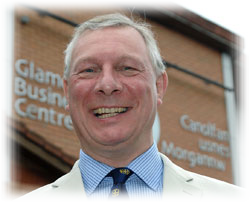
2) Afghanistan, 2001: They were flown in from Oman where the temperature was 32ºC and arrived in Bagram where it was minus 30ºC. There had already been 23 years of civil war so conditions were pretty grim. The main hospital in Kabul was built by the Russians so there was at least somewhere they could set up operations. The Afghan Minister of Health was a woman, Dr Suraya Dalil, who had been kicked out by the Taliban but brought back because there was nobody else that could cope with the terrible conditions. Whilst he was there a number of assasination attempts were made on him which he couldn't understand. Then someone pointed to him the armband he was wearing was the Red Cross, which, to the Taliban, was the sign of the Crusaders. He tried to find a Red Crescent armband but there was nothing available so he went without one. Again he showed us a collection of photos he had taken.
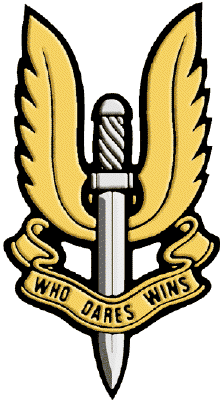
3) Iraq, 2003: Based in Kuwait, he recalled a rather funny situation before the day of the invasion. Iraqi soldiers were trying to surrender and were told to go away as it wasn't starting until the next day! This was an actual war that he had been really involved in and he said, "You've never been in a war until you've been bombed by the Americans!"
We all greatly enjoyed his talk and he was given a rousing applause at the end.
Cheers
John
We all greatly enjoyed his talk and he was given a rousing applause at the end.
Cheers
John
From: Gerry Davis, Bedminster
Sent: Friday, September 13, 2013 8:30 AM
Subject: The Annual Boy Entrant Reunion
Hi Tony,
Sent: Friday, September 13, 2013 8:30 AM
Subject: The Annual Boy Entrant Reunion
Hi Tony,
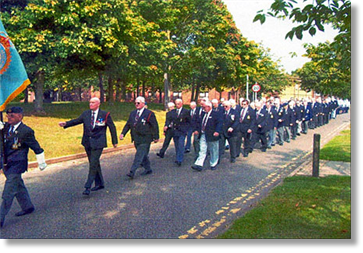
My buddy and I, once again, ventured North form Bristol to pastures near to RAF Cosford, for the Annual Boy Entrant get-together.
The weekend was great, I suppose it’s what you want to make of it yourself, but we two enjoyed ourselves immensely.
The atmosphere created by all those present, (134 this year) was electric. Everyone joined in the program of events, and what makes it special from other RAF meet-ups is that there is no division into status groups. Even the parade and the marching was carried out by all us lads so smartly and, what’s more, continually in step.
The weekend was great, I suppose it’s what you want to make of it yourself, but we two enjoyed ourselves immensely.
The atmosphere created by all those present, (134 this year) was electric. Everyone joined in the program of events, and what makes it special from other RAF meet-ups is that there is no division into status groups. Even the parade and the marching was carried out by all us lads so smartly and, what’s more, continually in step.
Nevertheless, the moral was not affected and we now eagerly await the next years special reunion, which celebrates the 80th year of the formation of the RAF Boy Entrants when young lads from 15 to 17 were trained at 10 different RAF camps, in a variety of trades from 1934 until 1965.
The photograph shows we are divided into two flights, marching to the RAF Cosford band, looking smart, wearing our RAF Boy Entrants badges on our blazers.
Gerry Davis
The photograph shows we are divided into two flights, marching to the RAF Cosford band, looking smart, wearing our RAF Boy Entrants badges on our blazers.
Gerry Davis
Although, there was one cause for concern, whilst seated in the hangar, waiting for the AVM to carrying out his inspection of the guard of honour followed by the Battle of Britain church service. Altogether it seemed to go on for what seemed like two hours. Now all we ex-brats are either sexagenarians, septuagenarians even some amongst us are octogenarians, which causes some concern when there are no bladder relief facilities.
From: Gordon Gray
Sent: Monday, September 16, 2013 2:03 PM
Subject: Contacts OBA
Hello Tony,
Just read with enthusiasm and interest as always your mails coming in. It really does make one sit and think, looking at the pinpoints [on OBA Earth] how our 'Globe' has shrunk with technological advance in communication. Is there a paradox there? All our overseas bases gone and in our context particularly RAF, with the demise and virtual disappearance of those bases that the pinpoints are everywhere, even if you were to ignore the Americas, the Far East and Australasia. Back in the early '60's who'd have thought of chatting (except by telephone with undersea cable, courtesy of Cable and Wireless) with a mate in Perth or Alaska?
Anyway, despite the foregoing I, with my wife, have recently returned from TRNC (Turkish Republic of Northern Cyprus) after 7 enjoyable years there. Sadly it came at an appropriate point as mother-in-law passed away unexpectedly several weeks ago leaving us a widower in his 90th year to care for. But it was always my intention to return to my country of birth (Scotland officially) before my 70th birthday; I just made it in time! But whilst there I spent a couple of consecutive years dropping down to Akrotiri with an ex-test pilot, to see the Red Arrows working up and meeting ex-Fat Albert Captains, ex-Air Chief Marshalls; particularly one who commanded 10 Squadron in the early years of the VC10 in service. Anyone guess who that was let me know... but no prizes!
What's my point in telling you all this? Well, if you wish and it's any interest to, please put the foregoing on the notice board, you have my permission. But I wonder what other 'old boys' of my era who are now in far flung places (Somalialand, 'Scouse' remember!) might think their intentions could be.
Sorry for all that Tony, but today is the 54th anniversary of my RAF attestation at RAF Locking in Somerset... just spent the weekend in the vicinity there with ex TRNC friends, who as we were, likeminded in returning ‘home.’
Fond Regards... also to all those who have my e mail address and connected with me in Turkish Cyprus (sadly not recognized in the rest of the world)
Gordon Gray
Sent: Monday, September 16, 2013 2:03 PM
Subject: Contacts OBA
Hello Tony,
Just read with enthusiasm and interest as always your mails coming in. It really does make one sit and think, looking at the pinpoints [on OBA Earth] how our 'Globe' has shrunk with technological advance in communication. Is there a paradox there? All our overseas bases gone and in our context particularly RAF, with the demise and virtual disappearance of those bases that the pinpoints are everywhere, even if you were to ignore the Americas, the Far East and Australasia. Back in the early '60's who'd have thought of chatting (except by telephone with undersea cable, courtesy of Cable and Wireless) with a mate in Perth or Alaska?
Anyway, despite the foregoing I, with my wife, have recently returned from TRNC (Turkish Republic of Northern Cyprus) after 7 enjoyable years there. Sadly it came at an appropriate point as mother-in-law passed away unexpectedly several weeks ago leaving us a widower in his 90th year to care for. But it was always my intention to return to my country of birth (Scotland officially) before my 70th birthday; I just made it in time! But whilst there I spent a couple of consecutive years dropping down to Akrotiri with an ex-test pilot, to see the Red Arrows working up and meeting ex-Fat Albert Captains, ex-Air Chief Marshalls; particularly one who commanded 10 Squadron in the early years of the VC10 in service. Anyone guess who that was let me know... but no prizes!
What's my point in telling you all this? Well, if you wish and it's any interest to, please put the foregoing on the notice board, you have my permission. But I wonder what other 'old boys' of my era who are now in far flung places (Somalialand, 'Scouse' remember!) might think their intentions could be.
Sorry for all that Tony, but today is the 54th anniversary of my RAF attestation at RAF Locking in Somerset... just spent the weekend in the vicinity there with ex TRNC friends, who as we were, likeminded in returning ‘home.’
Fond Regards... also to all those who have my e mail address and connected with me in Turkish Cyprus (sadly not recognized in the rest of the world)
Gordon Gray
From: Basil H J Hughes, Pattaya
Sent: Wednesday, September 18, 2013 4:46 AM
Subject: Re: OBA Pages Updated
Hello Tony (cannot say ‘Hi’ as it’s a dirty word in Thailand referring to a certain part of a lady’s anatomy),
Thank you for the update - great. I see people are listing their Air Mov's service -- I have been just trying to work mine out -- old age is creeping up on my memory etc.
I was called up 30th October 1957 after completing my apprentiship as a shipwrights and so was posted for training as a Clerk Air Movs -- I am dyslexic and colourblind!
1958 posted to Wildenrath -- Air Mov's Load Control Office doing weight and balances for Hastings, Valetta's and Varsity's.
Detached overnight to Sharjah for six months -- Bev's and Shack's
Returned to 5PDU sent on sick leave - dysentery - 1st Jan 1959 back to Wildenrath - MO sent us back to UK 6 weeks sick leave -- Belson Willy had nothing on us.
14 months in the RAF promoted to local acting Cpl and detached to Hamburg as a mobile air mover for Jever and Sylt Sqdn training detachments - Hamburg, living in the Stat Altona Hotel (five minutes walk to the Reaperbann and twenty minutes back). Drank enormous quantities of beer out of a glass boot.
1960 back to UK, 16 MU Surface Mov training and Explosive working Surface Mov's in Transportation.
1962-1963 Christmas Island and the less said about that the better.
Oct 1963 RAF Abingdon Mobile Air Mov Flight until in 1965 promoted to Sgt and moved to ATDU in the next hangar
1967 RAF Changi Air Movs where the whole shift including the female officer and the Flt Lt were up before the CO after being caught in a brothel -- always remember his comments -- to the WO -- Mr**** I would have thought you were too old for that sort of thing -- then he turned to the female officer and said what you were doing there I cannot understand -- taking coals to Newcastle -- All monthly shift parties banned unless we took our wives.
Finally I ended up at RAF Colerne -- stores disposal and computer punched cards
Sent: Wednesday, September 18, 2013 4:46 AM
Subject: Re: OBA Pages Updated
Hello Tony (cannot say ‘Hi’ as it’s a dirty word in Thailand referring to a certain part of a lady’s anatomy),
Thank you for the update - great. I see people are listing their Air Mov's service -- I have been just trying to work mine out -- old age is creeping up on my memory etc.
I was called up 30th October 1957 after completing my apprentiship as a shipwrights and so was posted for training as a Clerk Air Movs -- I am dyslexic and colourblind!
1958 posted to Wildenrath -- Air Mov's Load Control Office doing weight and balances for Hastings, Valetta's and Varsity's.
Detached overnight to Sharjah for six months -- Bev's and Shack's
Returned to 5PDU sent on sick leave - dysentery - 1st Jan 1959 back to Wildenrath - MO sent us back to UK 6 weeks sick leave -- Belson Willy had nothing on us.
14 months in the RAF promoted to local acting Cpl and detached to Hamburg as a mobile air mover for Jever and Sylt Sqdn training detachments - Hamburg, living in the Stat Altona Hotel (five minutes walk to the Reaperbann and twenty minutes back). Drank enormous quantities of beer out of a glass boot.
1960 back to UK, 16 MU Surface Mov training and Explosive working Surface Mov's in Transportation.
1962-1963 Christmas Island and the less said about that the better.
Oct 1963 RAF Abingdon Mobile Air Mov Flight until in 1965 promoted to Sgt and moved to ATDU in the next hangar
1967 RAF Changi Air Movs where the whole shift including the female officer and the Flt Lt were up before the CO after being caught in a brothel -- always remember his comments -- to the WO -- Mr**** I would have thought you were too old for that sort of thing -- then he turned to the female officer and said what you were doing there I cannot understand -- taking coals to Newcastle -- All monthly shift parties banned unless we took our wives.
Finally I ended up at RAF Colerne -- stores disposal and computer punched cards
Great Times
Now I, with the aid of spellcheckers, write books on Pembrokeshire History
They are on Amazon Books under Basil H J Hughes -- Fun and it keeps me occupied as the Doctor, in front of my wife, banned me from all cinemas (air con), air con Go-Go Bars, Smokey Bars, smokey restaurants, air con restaurants, places where Thai's are cooking chilli, viagra and sexy ladies!
All the very best to everyone
Bass
(How many of us are left from 62-65 the old MAMS flight?)
Now I, with the aid of spellcheckers, write books on Pembrokeshire History
They are on Amazon Books under Basil H J Hughes -- Fun and it keeps me occupied as the Doctor, in front of my wife, banned me from all cinemas (air con), air con Go-Go Bars, Smokey Bars, smokey restaurants, air con restaurants, places where Thai's are cooking chilli, viagra and sexy ladies!
All the very best to everyone
Bass
(How many of us are left from 62-65 the old MAMS flight?)
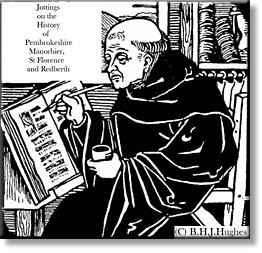
From: John Belcher, Chippenham
Sent: Thursday, September 26, 2013 12:34 PM
Subject: Gwen Millington
Tony Dunphy has informed us that Gwen Millington (w/o WO Roy), passed away on 17 Sept at home. The funeral will be 1200 Wednesday 02 Oct at Swindon Crematorium. Wake will be in the Carterton area.
Our thoughts are with her family.
John
Sent: Thursday, September 26, 2013 12:34 PM
Subject: Gwen Millington
Tony Dunphy has informed us that Gwen Millington (w/o WO Roy), passed away on 17 Sept at home. The funeral will be 1200 Wednesday 02 Oct at Swindon Crematorium. Wake will be in the Carterton area.
Our thoughts are with her family.
John
From: Sam Mold, Brighton & Hove
Sent: Tuesday, September 24, 2013 11:51 PM
Subject: AMS/MAMS/UKMAMS
Hi Tony,
The following is an extract copied from an ex-services website I found whilst trawling through the Internet:
UKMAMS : “Welcome to Forces Reunited the place where you can find information and friends from UKMAMS ... join and find out information and talk to UKMAMS friends now. Below are just some of our members who have served in UKMAMS.“
There followed a list of 54 names, along with times served. One of the names caught my eye by claiming: Baz Chappell was at UKMAMS between 1957 and 1986. (Is Baz one of our members?) Was the 1957 date quoted due to a typographical error?
I mention this as prior to 1951, the Movements trade was independent of the Supply trade when all store-bashers from AC2 up to WO were known as Equipment Assistants; whereas, Clerk Movements were solely employed on either road, rail, sea or air movement duties. As you know, these two separate trades were amalgamated into the newly formed Supply Trade Group (18) on 1st Jan, 1951, when Supp 1 & 2 trades (with annotated qualifications) absorbed all of the duties of both of these former trades.
Before 1951, movements trained personnel could be employed in any of its separate departments such as Sea Movements and Air Movements where their offices and activities were conducted on site. There were no Sections called MAMS or UKMAMS until around Oct,1958, when the Air Ministry formed a Development Unit at RAF Abingdon - hence known as AMDU/MAMS. I should know as I was shoe-horned out of my cushy little number in Abingdon’s Equipment Section and posted to this new lodger unit, where I was to join the only other Sgt on the Unit - Paddy Guerin. He is the only original member of that team who I remember, other than its first Sqn Ldr O/C (I believe his name was Taylor), an ex-aircrew “retread” transferred to the Supply branch. It was nice to know that (his brevet gave the game away), for it allowed me to bamboozle him by telling whopping great lies; ie: not knowing anything about Air Movements, not being Mov Q, etc., all in the hope of getting my posting cancelled. It’s no fault of mine if my new boss did not know that Supp 1’s were Mov Q; also, there was no way I was going to let on that I had served an AMS tour at Butterworth in 1953.
My main reason for not wanting this new posting to MAMS is in the name. I seriously needed stability - not mobility, and tried to explain to my new boss that this was the 12th posting I had “suffered” in the six years since leaving Benson in 1951. He didn’t give a damn, for now that his Unit was up to full strength he wasn’t going to release me. And yes, it would have ended my merry-go-round of postings, but what would be the point if those postings would be replaced by getting moved around with a MAMS unit? As Abingdon was a Transport Command Station, a simple call to HQ Transport Command at Upavon and our Sqn Ldr would have found out that all Supp 1's are Mov Q, and that’s precisely why they had posted me to the new AMDU/MAMS.
All my excuses to get my posting cancelled were obstructed by my boss counteracting them; first by sending me to Kidbrooke on a six-week (7th Jan to 20th Feb 59) Senior Movements course; then, after passing the course and returning to AMDU to tell the boss I didn’t have the first clue as to how an AMS operated, he was able to foil me again by arranging I spend a fortnight’s detachment to AMS Lyneham to learn the ropes. Yes, you’ve guessed it - there was no MAMS or UKMAMS unit at Lyneham! - only an AMS. The lies I told cost the RAF a lot of money and could well have led to a court-martial had they been exposed.
If my old mate Paddy is still around he can validate my story; alas, I haven’t seen or heard of him since we last met when he arrived as a Flt Sgt UKMAMS team leader on a Hercules unloading at Tengah during Exercise “Bersatu Padu”. I don’t know when MAMS morphed into UKMAMS or whether or not they were separate entities. By the way, I recently read in one of your newsletters that the first OC UKMAMS (Sqn Ldr Jacobs?) had died.
Not until 18th March ’59 was I able to escape from the clutches of AMDU/MAMS, neatly helped on my way by Transport Command when they posted me to their HQ at Upavon, It turned out to be a classic case of “out of the frying pan and into the fire.” My posting to HQ Transport Command only lasted seven months, and during that short time I had 20 detachments jumping here and there between all their flying Stations with the exception of Lyneham (totally committed to getting their newly arrived Britannia a/c into service). At the end of the “special” task, I was compensated by the SESO asking me what Transport Command Station I wish to be posted to? Without hesitation I said Northolt - and so it was.
Some while back I read on a website the “History of MAMS”. I believe the author (name of Jerry Porter?) claimed there were four MAMS units at Abingdon in 1958. If this was the case, why would Air Ministry set up a MAMS development unit if a MAMS organization was already in existence? Strange that none of us in AMDU/MAMS had heard of them. Abingdon’s Beverly’s were used solely for parachute training, and as they were not in a transport role there was no need for Abingdon to have an AMS. Had there been one on the station, my MAMS boss would not have sent me to Lyneham to learn how an AMS unit operated. Before “those in the know” all die off, it is important that we get our MAMS history accurate.
Please keep up the remarkably splendid work you do on behalf of UKMAMSOBA members. I really hope they all realize that but for your good self our Association would not exist, so it’s up to all of us to support you.
Sam Mold
Sent: Tuesday, September 24, 2013 11:51 PM
Subject: AMS/MAMS/UKMAMS
Hi Tony,
The following is an extract copied from an ex-services website I found whilst trawling through the Internet:
UKMAMS : “Welcome to Forces Reunited the place where you can find information and friends from UKMAMS ... join and find out information and talk to UKMAMS friends now. Below are just some of our members who have served in UKMAMS.“
There followed a list of 54 names, along with times served. One of the names caught my eye by claiming: Baz Chappell was at UKMAMS between 1957 and 1986. (Is Baz one of our members?) Was the 1957 date quoted due to a typographical error?
I mention this as prior to 1951, the Movements trade was independent of the Supply trade when all store-bashers from AC2 up to WO were known as Equipment Assistants; whereas, Clerk Movements were solely employed on either road, rail, sea or air movement duties. As you know, these two separate trades were amalgamated into the newly formed Supply Trade Group (18) on 1st Jan, 1951, when Supp 1 & 2 trades (with annotated qualifications) absorbed all of the duties of both of these former trades.
Before 1951, movements trained personnel could be employed in any of its separate departments such as Sea Movements and Air Movements where their offices and activities were conducted on site. There were no Sections called MAMS or UKMAMS until around Oct,1958, when the Air Ministry formed a Development Unit at RAF Abingdon - hence known as AMDU/MAMS. I should know as I was shoe-horned out of my cushy little number in Abingdon’s Equipment Section and posted to this new lodger unit, where I was to join the only other Sgt on the Unit - Paddy Guerin. He is the only original member of that team who I remember, other than its first Sqn Ldr O/C (I believe his name was Taylor), an ex-aircrew “retread” transferred to the Supply branch. It was nice to know that (his brevet gave the game away), for it allowed me to bamboozle him by telling whopping great lies; ie: not knowing anything about Air Movements, not being Mov Q, etc., all in the hope of getting my posting cancelled. It’s no fault of mine if my new boss did not know that Supp 1’s were Mov Q; also, there was no way I was going to let on that I had served an AMS tour at Butterworth in 1953.
My main reason for not wanting this new posting to MAMS is in the name. I seriously needed stability - not mobility, and tried to explain to my new boss that this was the 12th posting I had “suffered” in the six years since leaving Benson in 1951. He didn’t give a damn, for now that his Unit was up to full strength he wasn’t going to release me. And yes, it would have ended my merry-go-round of postings, but what would be the point if those postings would be replaced by getting moved around with a MAMS unit? As Abingdon was a Transport Command Station, a simple call to HQ Transport Command at Upavon and our Sqn Ldr would have found out that all Supp 1's are Mov Q, and that’s precisely why they had posted me to the new AMDU/MAMS.
All my excuses to get my posting cancelled were obstructed by my boss counteracting them; first by sending me to Kidbrooke on a six-week (7th Jan to 20th Feb 59) Senior Movements course; then, after passing the course and returning to AMDU to tell the boss I didn’t have the first clue as to how an AMS operated, he was able to foil me again by arranging I spend a fortnight’s detachment to AMS Lyneham to learn the ropes. Yes, you’ve guessed it - there was no MAMS or UKMAMS unit at Lyneham! - only an AMS. The lies I told cost the RAF a lot of money and could well have led to a court-martial had they been exposed.
If my old mate Paddy is still around he can validate my story; alas, I haven’t seen or heard of him since we last met when he arrived as a Flt Sgt UKMAMS team leader on a Hercules unloading at Tengah during Exercise “Bersatu Padu”. I don’t know when MAMS morphed into UKMAMS or whether or not they were separate entities. By the way, I recently read in one of your newsletters that the first OC UKMAMS (Sqn Ldr Jacobs?) had died.
Not until 18th March ’59 was I able to escape from the clutches of AMDU/MAMS, neatly helped on my way by Transport Command when they posted me to their HQ at Upavon, It turned out to be a classic case of “out of the frying pan and into the fire.” My posting to HQ Transport Command only lasted seven months, and during that short time I had 20 detachments jumping here and there between all their flying Stations with the exception of Lyneham (totally committed to getting their newly arrived Britannia a/c into service). At the end of the “special” task, I was compensated by the SESO asking me what Transport Command Station I wish to be posted to? Without hesitation I said Northolt - and so it was.
Some while back I read on a website the “History of MAMS”. I believe the author (name of Jerry Porter?) claimed there were four MAMS units at Abingdon in 1958. If this was the case, why would Air Ministry set up a MAMS development unit if a MAMS organization was already in existence? Strange that none of us in AMDU/MAMS had heard of them. Abingdon’s Beverly’s were used solely for parachute training, and as they were not in a transport role there was no need for Abingdon to have an AMS. Had there been one on the station, my MAMS boss would not have sent me to Lyneham to learn how an AMS unit operated. Before “those in the know” all die off, it is important that we get our MAMS history accurate.
Please keep up the remarkably splendid work you do on behalf of UKMAMSOBA members. I really hope they all realize that but for your good self our Association would not exist, so it’s up to all of us to support you.
Sam Mold
From: Dave Wilkin, Romford
Sent: Wednesday, September 25, 2013 3:54 AM
Subject: RAF BEA South Australia
I have been requested to keep you all informed as to the plans of the South Australian Branch of the RAF BEA for next year.
Thanks
Dave Wilkin
(Click on the Adobe image to download the .pdf file)
Sent: Wednesday, September 25, 2013 3:54 AM
Subject: RAF BEA South Australia
I have been requested to keep you all informed as to the plans of the South Australian Branch of the RAF BEA for next year.
Thanks
Dave Wilkin
(Click on the Adobe image to download the .pdf file)
